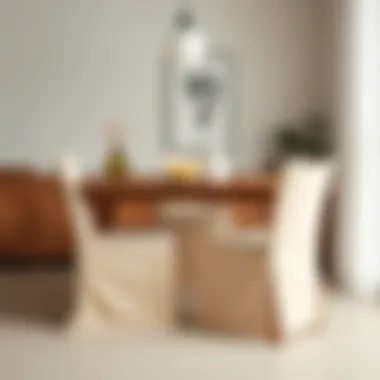Discovering the Elegance of Kitchen Chair Covers


Intro
When it comes to revamping your dining space, the importance of kitchen table chair covers cannot be overstated. They do more than just act as a protective layer; they are a gateway to expressing personal style while also addressing practical needs. One might ask, what exactly constitutes the right chair cover? Do these covers only serve aesthetic purposes, or do they bring in functionality as well? As we dive into this guide, we’ll navigate through various material options, styles, maintenance tips, and the overall impact that chair covers can have on your dining experience.
In a world where trends ebb and flow like the tide, understanding current market preferences can provide insight into making an informed choice regarding chair covers. From sleek modern designs to more traditional patterns, there’s practically a cover for every taste and decor.
So, let’s explore the trends molding the furniture scene today and delve into the DIY realm for those feeling crafty. After all, whether you’re a homeowner sprucing up your space or a designer looking for inspiration, there’s a wealth of information available that can help channel your creative ideas into reality.
Furniture Trends
Current Market Trends
The kitchen furniture market has seen interesting shifts over the past few years. With sustainability becoming a primary concern, eco-friendly materials are gaining traction. Fabrics made from organic cotton, recycled polyester, and even bamboo are now common in stores. These materials not only embrace environmental responsibility but also offer durability suitable for daily use.
Another noteworthy trend involves bold colors and prints. Classic neutrals still have their place, but there’s a growing demand for vibrant hues and unique patterns. People are increasingly keen on making a statement with their dining areas, often opting for covers that bring life and energy into the room.
Color and texture choice influences mood; a splash of color can uplift and invigorate the dining experience.
Popular Styles and Designs
In terms of styles, you'll find an array to choose from. Casual farmhouse aesthetics commonly feature slipcovers that provide an inviting, relaxed vibe. Think linen or soft cotton in muted shades for a natural look. On the flip side, contemporary styles showcase sleek, tailored covers often crafted from synthetic fibers that resist staining and wear.
When considering designs, checkered or floral patterns resonate well with traditionalists, while geometric shapes appeal to those with a modern sensibility. Vintage-inspired prints are making comebacks too, tapping into the nostalgia of yesteryears.
- Farmhouse Style: Relaxed and inviting, usually in soft, muted colors.
- Contemporary Style: Tailored and clean lines, excellent for modern kitchens.
- Vintage Prints: Nostalgic designs that create a warm atmosphere.
The covers you choose not only reflect your personality but also support the overall theme of your dining room.
DIY Projects
Step-by-Step Guides
Feeling crafty? Whether you want to save money or enjoy the process, DIY projects focused on chair covers can be fulfilling. Start by measuring your chairs to ensure the correct fit. With these dimensions, you can draft a simple pattern that accommodates the chair’s shape. Consider using fabric that complements the existing decor—it can often be a great way to recycle old materials.
- Measure Your Chairs: Width, height, and depth.
- Choose Your Fabric: Look for something durable yet appealing.
- Cut the Pattern: Using fabric scissors, cut according to the measurements.
- Sew or Glue: Depending on your comfort level, either sew the pieces together or use fabric glue.
- Fitting: Ensure the covers fit snugly. Adjust if necessary.
Budget-Friendly Ideas
For those on a budget, no need to break the bank. You might consider upcycling old towels, tablecloths, or even bed sheets. Simple fringe trim can add flair to plain fabric, making it uniquely yours. It’s all about creativity; remember that your dining area should reflect your personal style without becoming exorbitantly expensive.
In summation, lifestyle preferences influence our choices in chair covers. From styles that redefine our spaces to practical DIY projects, the right cover can transform your kitchen’s aesthetic and functionality. Taking the time to choose wisely will pay off in the long run, allowing you to enjoy your dining experience even more.
For further exploration, visit Wikipedia on Home Decor, or check out forums on Reddit for community insights.
Preamble to Kitchen Table Chair Covers
In the realm of interior design, kitchen table chair covers often slip under the radar. However, these covers serve more than just decorative purposes; they are vital tools for enhancing both the style and longevity of your kitchen seating. Homeowners, renters, designers, and DIYers alike should take a moment to appreciate the multifaceted value of chair covers.
One of the main reasons chair covers are essential is their protective role. Over time, kitchen chairs endure significant wear and tear due to daily use. Spills, stains, and general degradation can weaken their structure and appearance. Here’s where chair covers come into play. They provide a barrier against these inevitable mishaps, preserving your chairs and potentially saving you the costs associated with replacement or expensive cleaning services.
From an aesthetic perspective, chair covers are a game changer. They give you the freedom to alter the vibe of your dining space with ease. For example, switching from solid colors to vibrant patterns can dramatically shift the atmosphere from somber to lively. If you love hosting dinner parties, a stylish cover can make all the difference in creating an inviting environment for your guests. You can mix and match fabrics and colors to reflect seasonal themes or even your mood, bringing flair without the commitment of new furniture.
Also, let’s not forget about practicality. Many chair covers are washable and easy to maintain, making them a smart option for busy households. Wiping spills or tossing the covers in the wash is often simpler than trying to clean a fabric chair directly. So, for those with kids or pets, this feature can be a massive relief.
There are several important considerations when choosing kitchen table chair covers. Beyond protection and looks, think about materials, fit, and style—each element can transform your dining area. Properly fitted covers not only look better but also remain in place, ensuring comfortable seating. Although it seems like a small detail, taking the time to select the appropriate chair covers will positively impact your overall kitchen experience.
"Chair covers are more than just a protective layer; they redefine your space, bringing both style and functionality to the table."
In summary, kitchen table chair covers are an excellent investment that marries style with practicality. They protect your furniture, elevate your décor, and reflect your personal taste—all factors that make them worthy of consideration for any home's design.
Importance of Chair Covers in Interior Design
When you think about sprucing up your home, the spotlight often shines on paint colors, wall art, or even plant arrangements. Yet, chair covers play a significant role that can easily be overlooked in the grand tapestry of interior design. They serve not just a practical purpose, but also inject personality and flair into a space. Understanding the importance of these coverings can truly elevate the ambience of your dining area.
Protection Against Wear and Tear
One of the primary reasons for using chair covers is their protective function. Daily use can take a toll on furniture—especially in a busy kitchen or dining area where spills, stains, and general wear seem inevitable. Chair covers act as a first line of defense.
- Shield from Spills: Imagine enjoying a lively dinner where an enthusiastic gesture spills wine onto the fabric of a cherished chair. A cover can absorb or deflect these mishaps, saving your beloved seats from permanent damage.
- Guard Against Scratches: Whether it's from pets jumping up to investigate or kids who don’t always remember their manners, chair covers help mitigate these risks. It's a simple yet effective way to prolong the life of your furniture.
- Ease of Maintenance: Many chair covers are designed to be removable and washable. This convenience makes it far easier to maintain hygiene without having to stress about complex cleaning processes.
In short, by opting for chair covers, you aren’t just dressing your chairs up; you’re preserving their integrity against the wear and tear that comes with everyday life.
Enhancing Aesthetic Appeal
Beyond their practical aspects, chair covers play a vital role in enhancing the overall look and feel of your space. They’re not merely functional; they also have the power to transform, uplift, and refine your dining environment.
- Personal Expression: Choose chair covers in bold colors, whimsical patterns, or even textured fabrics to express your unique style. A vibrant floral pattern can inject charm into an otherwise stark room, while muted tones may offer a calming balance to a vibrant table setting.
- Cohesive Design: Chair covers can subtly pull together various elements of your interior design. If you have a farmhouse table but want to introduce a modern flair, pairing sleek covers can harmonize those contrasting styles.
- Seasonal Updates: One of the unique advantages of using chair covers is the ability to change them with the seasons or holidays. Cozy, warm tones in fall contrast beautifully against crisp whites and pastels in spring, allowing you to keep your space fresh and engaging throughout the year.
"The right chair cover can wrap your furniture in a disguise of elegance or playfulness, framing a visual story every time you gather around the table."
In essence, chair covers are not just protective apparel for your furniture; they are integral pieces of your home’s aesthetic puzzle, delivering both beauty and functionality.
Material Options for Chair Covers
When it comes to selecting chair covers for your kitchen table, the choice of material can hugely influence both the longevity of the covers and the overall look of your dining space. Not only do various materials provide different aesthetic qualities, but they also come with a set of practical advantages and considerations. Different textures, colors, and finishes can easily transform the vibe of a room, ensuring it reflects your personal style. Moreover, understanding the implications of each material can help you make a wise decision, fitting your specific needs and lifestyle seamlessly.
Fabric Choices: Cotton, Linen, and More
Natural fibers have always held a special place in home decor, and cotton and linen are often at the forefront of chair cover options. Cotton, for instance, is not only affordable but also straightforward in terms of maintenance, making it a popular choice among many homeowners. It’s breathable and soft to the touch, providing comfort while dining. Moreover, cotton can come in various patterns and colors, giving you that versatility you’re looking for.
Linen, on the other hand, carries a certain elegance that makes it stand out. Although a bit pricier, its natural luster and texture bring a refined quality to your dining area. Linen is less prone to fading, and with proper care, it can last for years. Just be aware, it tends to wrinkle easily, but some consider that part of its charm. Together, these fabrics offer a range of possibilities, allowing homeowners to showcase their unique taste.


"Choosing the right fabric for your chair covers can completely redefine the dining experience. It’s all about comfort with flair!"
Some may also consider using blends that combine cotton with polyester or rayon for additional durability or stain resistance. These mixed fabrics tend to be less prone to wear and are often easier to clean, making them practical for families with lively children or pets.
Synthetic Materials: Durability and Care
Moving onto synthetic fabrics, such as polyester and nylon, it’s crucial to note their advantages, especially in terms of durability. These materials are designed to withstand more wear and tear compared to natural fibers. If you have a dynamic household, these might be the chair covers for you. They resist stains and fading far better than their cotton and linen counterparts, which can significantly extend their usable lifespan.
Caring for synthetic materials is quite user-friendly as well. Most are machine washable and dry quickly, which can be a major bonus when life gets busy. Places like goodhousekeeping.com frequently cover best care practices for such materials, ensuring you can keep your covers looking fresh without a hitch.
However, be mindful that synthetic fabrics may not offer the same breathability as natural options, which can be a downside during warmer months. It's also worth considering if you value the environment, as production processes of synthetics can have a larger ecological footprint compared to natural fibers.
Eco-Friendly Options in Chair Covers
As sustainability becomes increasingly important, eco-friendly chair cover options have gained traction. Many companies are now producing materials derived from organic cotton or recycled fabrics. This is an excellent way to not just beautify your home but also contribute positively to the planet. Organic cotton is grown without harmful pesticides and chemicals, making it a safer choice for households with children and pets.
Bamboo fabric is another innovative alternative. It’s natural, biodegradable, and highly renewable, boasting antibacterial properties that make it both fashionable and functional. Cover options using Tencel or linen blends are gaining popularity for their soft feel and reduced environmental impact.
When choosing sustainable materials, always check for certifications from reputable sources, ensuring that you are genuinely making an eco-conscious decision. Resources like thegoodtrade.com provide guides to help identify sustainable practices in home goods and fabrics.
Styles of Chair Covers
When it comes to chair covers, their style isn't just about appearances; it's about weaving together aesthetics and functionality in a way that sets the mood for your dining area. The various styles of chair covers can transform a mundane setting into something extraordinary. A well-selected chair cover can echo social gatherings and family meals, enhancing the overall experience.
For homeowners, renters, or anyone who spends time around the kitchen table, understanding styles can unlock the true potential of their living space. They can align the design of their covers with the overall theme of the home or give a refreshing twist to the existing decor, making it feel new again.
This section explores the nuances of chair cover styles by diving into two core frameworks: the difference between formal and casual styles, and the battle between contemporary and vintage designs. Each of these offers a unique lens through which to view chair covers, illuminating their importance in delivering not just comfort, but also character.
Formal vs. Casual Styles
Formal styles are characterized by their elegance and sophistication. They often utilize rich fabrics such as silk or velvet, and may feature intricate designs or embellishments. These covers can turn an ordinary dinner into a grand affair. Great for special occasions, they can elevate the dining experience and make guests feel cherished. For instance, a detailed brocade chair cover draped over a wooden chair can instantaneously uplift the visual interest of the dining setting.
On the other hand, casual styles provide a relaxed, homey atmosphere. Typically made from more breathable materials like cotton or linen, these covers can withstand the rough and tumble of daily use. They are often found in a variety of playful colors and prints, making them versatile for informal gatherings or day-to-day meals. In practical terms, casual covers are easier to clean and maintain, thus catering better to families with young kids or pets.
A chair cover should reflect the tone of the event, whether it’s a cocktail party or a laid-back brunch with friends.
When choosing between formal and casual styles, consider the occasions you host most frequently. Are your dinner parties more of a sit-down affair or do you often enjoy casual meals with family? This consideration goes a long way in deciding which style fits your needs best.
Contemporary vs. Vintage Designs
Contemporary designs in chair covers emphasize minimalism and modern aesthetic. They favor clean lines and a sleek look, often featuring geometric patterns or monochromatic colors that resonate with modern decor trends. Perfect for urban living spaces, these covers allow a seamless blend between the furniture and the decor, frequently complementing other modern fixtures like metal fixtures or glass tabletops.
Conversely, vintage designs evoke nostalgia and charm. They capture intricate patterns, floral motifs, or retro colors that take you back in time. Vintage chair covers can add a warm, inviting feel to any space, echoing tales of family gatherings from the past should you choose fabric with a touch of history. If someone stumbled upon a cover featuring delicate embroidery with a worn-out look, they might find it lends a story to their dining experience.
Selecting between contemporary or vintage designs can also define the overall tone of the dining room. A contemporary cover might be just the touch needed in a sleek, modern home, while a vintage cover could soften the edges of more formal settings, bringing warmth and whimsy.
In essence, understanding the various styles of chair covers allows you to tailor your dining area to better reflect your own personality and the atmosphere you wish to create. Whether you're leaning towards the dressy flair of formal styles or the laid-back vibe of casual options, your choice of chair covers can significantly enhance your dining experience.
Measuring for Chair Covers
Measuring for chair covers is a fundamental step that can’t be overlooked. Getting the right fit ensures that the chair covers will look appealing while providing the necessary protection. If you skip this step, you might find your hard-earned investment in a beautiful fabric mocks you as it billows awkwardly in the breeze or conversely, suffocates your chair in a tight, unflattering hug. Thus, measuring accurately is not just about numbers; it’s about achieving a seamless look.
Understanding Different Chair Shapes
When measuring for chair covers, it’s paramount to grasp the various chair shapes on the market. Each shape lends itself to specific cover styles, and knowing the ergonomics can save you a lot of headache. Standard dining chairs are usually straightforward, but once you venture into the realm of armchairs, benches, or even uniquely shaped pieces, things get a little tricky.
- Traditional Dining Chairs: Typically have a straight back and seat with uniform dimensions.
- Armchairs: These often have wider dimensions due to the additional width from the arms, so measuring around them becomes necessary to accommodate their size.
- Benches: Longer and require thoughtful measurements to ensure the cover fits without sagging or bunching.
- Accent Chairs: Various styles exist, so the measurements must cater to distinctive designs.
Understanding these shapes allows you to tailor your measurement approach.
How to Take Accurate Measurements
So, how does one go about measuring their chairs properly? Here’s the nuts and bolts of it:
- Gather Your Tools: All you need is a fabric measuring tape, a pen, and some paper. Simple stuff, really.
- Measure the Seat: Start by measuring the width and depth of the seat. For a side chair, ensure you measure from the front edge to the back of the seat. If you own an armchair, make sure to measure from the front edge to around the arms as well.
- Assess the Backrest: Chair backs can vary—some chairs may have a high back while others are low or even armless. Measure the height from the seat to the top of the backrest, along with the width to confirm how much fabric you’ll need.
- Consider the Arm Height: If your chairs have arms, you’ll want to measure their height from the seat to the top of the armrest. This is where neglecting the arms leads to ill-fitting covers.
- Round It Up: When noting down your measurements, always round up to the nearest inch. It helps to account for any potential drawbacks in fabric stretch or shrinkage during washing.
Maintenance and Care for Chair Covers
Chair covers are often the unsung heroes of dining spaces. They not only enhance the aesthetic allure of your kitchen table but also serve practical purposes. Maintaining and caring for these covers is crucial for ensuring longevity and preserving their original charm. Regular upkeep helps avoid wear and tear, keeps colors vibrant, and minimizes the risk of unpleasant odors. In this section, we’ll explore effective cleaning methods, and storage tips to ensure your chair covers remain in top shape.
Cleaning Methods for Various Fabrics
The fabric of your chair covers will dictate the best cleaning approach. Different materials have unique care requirements, which means there’s no one-size-fits-all method. Here are a few common fabrics and your cleaning guide:
- Cotton: One of the most user-friendly options. Machine-washable and can often withstand regular cycles. Consider using cold water to prevent shrinking, and tumble dry on low heat.
- Linen: Requires a gentle touch. Hand wash or machine wash on a delicate cycle with cold water. Air drying is preferable, as heat can cause linen to lose its natural crispness.
- Polyester: Sturdy and stain-resistant, polyester covers can be tossed in the washing machine. Use warm water and a gentle detergent. They also tend to dry quickly, making them convenient for busy households.
- Leather and Faux Leather: Wipe with a damp cloth and use a pH-neutral cleaner. Avoid soaking as this can damage the material.
Tip: Always check label instructions for specific care guidelines. If unsure, conduct a small patch test on less visible areas to assess how the fabric responds to cleaning products.
Storage Tips for Seasonal Use
When the seasons turn, your chair covers might need to take a break. Proper storage ensures that they remain pristine and ready for the next use. Here are several storage tips to consider:
- Clean Before Storing: Always wash and thoroughly dry your chair covers before putting them away for a while to avoid mold and musty odors.
- Use Breathable Storage Bags: Opt for cotton or other breathable materials instead of plastic to prevent moisture buildup, which can damage fabric over time.
- Avoid Compression: Storing chair covers flat or loosely folded can help maintain their shape. This way, you protect against creasing and unwanted wrinkles.
- Keep in a Cool, Dry Place: A dark closet or a drawer helps safeguard colors from fading. High humidity or excessive heat can warp fabrics, so a stable environment is key.
By following these simple yet effective maintenance and care tips, you can extend the life of your chair covers significantly. Regular attention will keep your spaces looking fresh, ensuring that they always make a good impression.
Color and Pattern Coordination
In the realm of interior design, color and pattern coordination might just be the unsung heroes of a well-styled space. Particularly for kitchen table chair covers, the choices you make here can take an ordinary setup and transform it into something truly special. It's not just about what looks good; it’s about creating a cohesive vision that resonates with the mood you want to set and the message you wish to communicate about your home. When done right, your chair covers can harmonize with other aspects of your dining area, tying the whole aesthetic together nicely.
Using Color Theory for Interiors
Color theory goes beyond the color wheel; it includes understanding how colors interact, evoke feelings, and influence the atmosphere of a space. For your kitchen table chair covers, you might want to adhere to these principles to ensure you don’t end up in a colorful mess.


Starting with the basics, you can consider:
- Complementary Colors: Think of blue and orange, opposites that enhance each other. If your dining room walls are a subtle shade of blue, an orange chair cover can create a vibrant pop.
- Analogous Colors: These are colors next to each other on the color wheel, like blue, blue-green, and green. They provide a smoother, more cohesive look.
- Monochromatic Schemes: Stick to different shades and tints of one color family. For instance, various shades of gray can look sophisticated and modern when combined wisely.
By utilizing color theory effectively, you create a design where everything feels intentional. This natural visual rhythm can make spaces feel larger or more inviting, depending on the palette you pick.
Pattern Mixing: Dos and Don'ts
Pattern mixing is where many people get lost, often trying to juggle too many prints that clash rather than complement. Luckily, with a few simple guidelines, you can avoid the pitfalls of chaotic design. Here are some dos and don’ts for mixing patterns in your chair covers:
Dos:
- Do Mix Different Scales: Pair a large floral cover with smaller polka dots. The interaction creates interest without overwhelming the eye.
- Do Stick to a Common Color Palette: When combining patterns, ensure that they share some colors. This unites them and creates harmony within the blend.
- Do Use Solids in Between: If you’re overlapping multiple patterns, use solid-colored chair covers or cushions to break up the visual and create breathing space.
Don'ts:
- Don’t Overdo It: Limit yourself to three different patterns at most. Too many prints can create visual chaos.
- Don’t Ignore Scale: Patterns that are too similar in scale can fight for attention, creating a confusing look. Always mix sizes.
- Don’t Forget to Test It Out: Lay out different combinations before you make a decision. Sometimes, a pairing that looks good in theory may not hold up in practice.
In the end, coordinating colors and patterns isn’t just an exercise in aesthetics; it represents the very essence of your home’s personality. With thoughtful color choices and an eye for patterns, your kitchen table chair covers can serve as the perfect finishing touches, harmonizing with the surrounding decor while elevating your dining experience.
Remember: Design is a personal journey. Don’t shy away from experimenting until you find that magical combination that speaks to you.
For more insights into interior design, you can refer to resources like Britannica or explore forums on Reddit.
Keeping these principles in mind will not only enhance your chair covers but also the overall aesthetic of your dining space.
Cost Considerations
When it comes to kitchen table chair covers, price plays a pivotal role in the decision-making process. Homeowners, renters, and designers must balance the need for aesthetic appeal with their budgetary constraints. Each option presents a unique set of benefits and considerations, so understanding the cost implications is paramount.
Investing in chair covers can allow individuals to elevate their dining experience without breaking the bank. Yet, while buying the cheapest options might seem appealing, it's crucial to think beyond the sticker price. Selecting covers requires foresight; a low-cost option that wears out quickly can lead to more frequent replacements, ultimately costing more in the long run. This section explores various facets of cost considerations, helping you make informed decisions when selecting the right chair covers for your interiors.
Budget-Friendly Options
Finding cost-effective chair cover solutions doesn't have to mean sacrificing style. There are plenty of budget-friendly options available that maintain both functionality and flair:
- Cotton Covers: Inexpensive and easy to care for, cotton chair covers come in numerous colors and patterns. They’re breathable and perfect for casual settings.
- Stretch Covers: These elasticized covers can fit various chair shapes and sizes, offering versatility without a hefty price tag. They usually come in plain colors, making them suitable for any decor.
- Polyester Blends: Covers made from polyester are often less expensive than natural fibers. They resist stains and wrinkles, making them a practical choice for busy homes.
"A budget doesn’t have to limit your creativity; it can spark resourcefulness."
- DIY Options: If you're handy with a sewing needle, consider crafting your own covers. Using remnants from fabric stores can significantly cut costs and provide a custom touch.
These options ensure that everyone can find suitable covers that don’t drain their wallets while still sprucing up the dining area.
Investment in Quality Covers
While budget-friendly options serve a purpose, investing in high-quality chair covers can pay off in numerous ways:
- Durability: Quality materials like leather or high-thread-count cotton can withstand daily use and resist wear and tear. By opting for these materials, you reduce the need for frequent replacements, which can save money in the long term.
- Enhanced Aesthetic: Higher-quality covers often feature intricate designs and better finishes. This can elevate the overall look of your dining space, giving it a more polished and intentional appearance.
- Comfort and Fit: Premium covers are generally more tailored and can provide a snug fit over various chair types. This not only looks better but also adds to the comfort of the dining experience.
Be mindful of your budget but also consider the long-term value of your purchase. Quality can be a rewarding choice that transforms your dining area into a stylish yet functional space.
Customization and DIY Options
In the realm of kitchen table chair covers, customization and DIY options stand out as avenues not only for personal expression but also for practical utility. These covers serve as a canvas for creativity, allowing homeowners to tailor their dining spaces to reflect individual character and preferences. Unlike mass-produced alternatives, custom covers can accommodate various chair styles and sizes, ensuring a flawless fit that adds a polished look to any setting.
Moreover, embarking on a DIY project can yield significant cost savings. With a bit of fabric, some sewing supplies, and a sprinkle of ingenuity, you can create chair covers that align with your specific aesthetic while staying well within budget. This personalized approach not only enhances the visual appeal of your dining area, but it also fosters a sense of achievement and ownership over your living space.
While customizing chair covers can seem daunting, there are several approaches to consider. Before diving into the world of fabrics and threads, it's essential to weigh the benefits and considerations that come with this hands-on undertaking.
- Individual Creativity: Crafting your own covers opens up a world of design possibilities. You choose the colors, patterns, and textures that resonate with your style.
- Perfect Fit: Each chair is unique, and sometimes ready-made covers just don’t cut it. DIY allows for precise fits, tailored to your chair’s dimensions.
- Sustainable Practices: Creating covers from leftover materials not only reduces waste but also promotes an eco-friendly lifestyle.
With these points in mind, let’s explore two specific DIY avenues: sewing your own chair covers and upcycling old fabric.
Sewing Your Own Chair Covers
Sewing your own chair covers presents a fulfilling challenge that allows one to gain new skills while addressing a practical need. When you take on this task, you not only customize how your chair looks but also dictate its tactile feel, durability, and care requirements.
Before sitting down at the sewing machine, there are a few preparatory steps to consider:
- Select Your Fabric: Choose a material that complements your home’s decor. There’s a broad spectrum of options, from cotton and linen to more robust choices like canvas or denim.
- Gather Tools: Prepare your sewing toolkit, which should include a sewing machine, measuring tape, scissors, pins, and thread that matches your fabric.
- Measure Accurately: Take precise measurements of your chairs. Ensure you take into account not just the size but also the shape, as many chairs have unique designs that may require unique covers.
Once you have your fabric and measurements, drafting a simple pattern is the next step. Using parchment or regular paper, sketch the outline of your chair’s seat and back. Following this template, cut your fabric accordingly, ensuring you leave extra material for seams.
From there, it's all about assembling your pieces. Start by sewing the edges, then add any desired embellishments like piping or decorative stitches. With patience and attention to detail, your one-of-a-kind chair covers will be ready to grace your dining space.
Upcycling Old Fabric for New Covers
Upcycling provides a sustainable approach to creating chair covers while reintroducing forgotten treasures into your home decor. Old fabric, whether from discarded clothing, bed linens, or remnants, can be transformed into visually stunning covers with a story to tell. This process not only helps reduce waste but also lends a deeply personal touch to your dining area.
Here’s how to approach upcycling effectively:
- Source Your Fabric: Look for items you no longer use or explore thrift stores for unique fabric pieces. Look for patterns and textures that can invigorate your dining room.
- Design Concept: Sketch out a vision for your chair covers. Combining different fabrics can introduce a playful element through patchwork designs, while solid colors can create a minimalist vibe.
- Preparation: Clean the fabric thoroughly to ensure freshness. Remove any stains or odors that may linger from its previous life.
Once ready, measure your chairs and cut your upcycled fabric according to the dimensions gathered. The sewing process is very similar to creating covers from new fabrics; however, you might want to embrace the imperfections that give each cover a unique character. Incorporate mismatched pieces intentionally for a personalized eclectic look.
Upcycling adds charm and a sense of authenticity to your chair covers, making them not just functional items but also conversation starters in your home.
Seasonal Versatility
Embracing the changing seasons in your home decor can breathe new life into your dining space, and kitchen table chair covers play a pivotal role in this transformation. The versatility of chair covers makes them ideal for enhancing your interior aesthetics throughout the year. It’s not just about keeping the furniture clean; it’s about creating different moods and atmospheres that reflect the seasonal changes. By selecting the right designs and fabrics for each time of year, homeowners can effortlessly switch their dining area from a cozy winter hideaway to a bright summer retreat.
Adapting Covers for Different Seasons


When it comes to adapting chair covers for each season, one must consider not just the colors but also the materials that depict the essence of each period. For instance, in fall, warming fabrics like chenille or thick cotton in earthy hues can evoke a sense of coziness. In contrast, summer might call for lighter, breezy fabrics such as cotton or linen that are easy to clean and enhance airflow. Here are additional tips for each season:
- Spring: Light floral patterns can bring freshness, pairing well with pastel colors. Think of cheerful shades that reflect new blooms, like soft pinks, yellow, and vibrant greens.
- Summer: Opt for bright, vibrant colors. Bold prints and lightweight fabrics add a refreshing feel. Consider using water-resistant materials if your dining area is outdoors.
- Autumn: Swap out for warm tones—deep oranges, rich browns, and festive patterns resonate with the seasonal harvest. Materials that offer warmth and charm should be prioritized.
- Winter: Heavy fabrics in dark, rich colors can add warmth. Patterns with a winter theme, such as snowflakes or Christmas motifs, can transform your dining space into a holiday haven.
Holiday Themes and Decorative Changes
Holiday seasons provide an exceptional opportunity to play with chair covers. Using thematic designs can tie your overall decor together effortlessly. For example, during the holidays, you might select covers adorned with festive motifs, such as snowmen for winter holidays or vibrant patterns indicative of summer barbeques. Here are some suggestions for incorporating holiday themes into your chair covers:
- Christmas: Use covers with winter wonderland designs or rich red and green tartans. Adding a quilted texture can provide an inviting touch.
- Thanksgiving: Fall leaves or pumpkin prints encompassed in warm tones like cranberry, burnt orange, and olive can invoke gratitude and the spirit of togetherness.
- Easter: Soft pastel covers with floral or bunny patterns can add a light-hearted feel to your dining space, creating a joyful atmosphere.
- Fourth of July: Red, white, and blue striped or star-patterned covers can celebrate national pride while keeping the aesthetic festive.
Change is a hallmark of life, and what better way to reflect that than through your decor? By selecting appropriate chair covers that align with each season and celebration, you don’t just protect your furniture; you create a warm and inviting space that resonates with everyone who gathers around the table.
Trends in Chair Cover Design
Chair covers are more than just an afterthought; they play a pivotal role in setting the mood of any dining space. As trends evolve in home decor, chair cover designs have adapted to reflect current styles, preferences, and even values. From the material to the pattern, the choices you make can enhance your home's character while providing durability and comfort.
Current Trends to Observe
Right now, the industry is buzzing with several noteworthy trends:
- Natural Fabrics: Organic materials like cotton and linen are making a comeback, appealing to those who prioritize sustainability. This shift is seen as not just a style choice, but as a lifestyle preference.
- Bold Patterns & Colors: From tropical motifs to geometrical designs, the days of muted covers are fading. People are opting for covers that add a splash of personality to their spaces.
- Texture Play: Incorporating varying textures, like velvets or quilted designs, is another trend that adds depth to the decor, allowing homeowners to mix and match without clashing.
"Chair covers can serve as the icing on the cake for your dining decor—a way to express your style and comfort while protecting your furniture."
Moreover, incorporating trims, tassels, and even embroidery provides a touch of elegance that can transform the ordinary into the extraordinary.
Anticipating Future Styles
As we gaze into the future of chair cover design, several exciting developments are on the horizon.
- Smart Fabrics: Imagine covers that can change color or pattern with a simple app on your phone. While this might sound like something from a science fiction novel, advancements in materials are making it increasingly feasible.
- Biodegradable Options: As the focus on environmental sustainability grows, expect to see more options that not only look good but also break down naturally at the end of their life cycle.
- Customization and Personalization: Furniture might be evolving toward a more bespoke experience. More brands are likely to offer tailor-made chair covers individual to customer lifestyles, creating a unique interaction between the homeowner and designer.
Understanding these trends helps us not only refresh our spaces but also align our choices with a deeper sense of responsibility towards our environment and style. As we move forward, being mindful of these shifts can keep your dining area both trendy and timeless.
Case Studies: Successful Design Integrations
This section zeroes in on how various homes have harnessed the power of chair covers to either blend with existing decor or breathe new life into tired spaces. The case studies selected showcase distinct methods and styles that can inspire anyone, from the casual homeowner to the seasoned designer. The importance of examining these real-life applications lies in their ability to highlight practicality alongside aesthetic choices, making clear how chair covers function as versatile design elements.
Transformative Uses in Various Homes
In a modest suburban residence, one family transformed their kitchen's gloomy atmosphere simply by introducing vibrant chair covers made from cheerful yellow cotton fabric. Before the update, the space had been dull and uninviting, clad in neutral tones. The covers, adorned with playful patterns, acted like an instant mood booster. They encouraged the family to gather more often, making mealtime a more joyous occasion.
"Chair covers provide a quick, affordable way to switch up your home's vibe without diving into a full renovation."
In contrast, a contemporary loft with industrial charm used sleek, dark leather covers to enhance its urban edge. Here, the choice of material was crucial; not only did the leather complement raw concrete features, but it also added a touch of luxury. This integration highlighted how shape and texture can interact powerfully with the overall ambience of a space.
Another engaging example comes from a couple who decided to upcycle vibrant, patterned fabric from old curtains into covers for vintage chairs. Their decision was rooted in both sustainability and nostalgia. The creative re-use brought a fresh perspective to the dining room while simultaneously telling a story of the couple's journey. These case studies collectively underscore the importance of choice in material, style, and context, illustrating that the effectiveness of chair covers often rests on the nuances of personal taste and environmental cohesion.
Expert Insights on Effective Covers
Experts frequently advocate for a thoughtful approach when selecting chair covers. It isn’t just about choosing something that looks good; it’s equally about functionality and fit. An interior designer once mentioned that the perfect cover can change not only the aesthetic but also the feel of a room, affecting how space is perceived by guests and inhabitants alike.
- Material Choice: Selecting the right fabric can mean the difference between a comfortable seating experience and one that detracts from your enjoyment. A designer might suggest mixing textiles—using more tactile fabrics like velvet or linen for comfort against the smoothness of leather or synthetics.
- Fit and Function: A well-fitted cover doesn't slide around; it stays put, thus prolonging the life's longevity of both the cover and the chair itself. Measurements are critical. If a cover is too loose, it may actually compromise the chair’s usability.
- Versatility with Style: Many experts recommend having multiple sets of covers on hand. This allows homeowners to swap out styles seasonally or during different celebrations. Consider festive patterns during the holidays, more subdued tones during everyday settings, and bright designs for casual gatherings.
By examining how different individuals and professionals approach the subject of chair covers, we can gain deeper insights into what truly makes a successful design integration. The stories shared here illustrate that thoughtful considerations lead to harmonious living spaces where aesthetics and practicality flourish side by side.
Sustainability Considerations in Chair Covers
Sustainability is an increasingly important conversation in all areas of design, and kitchen table chair covers are no exception. From eco-conscious consumers to designers focused on a holistic approach, the drive for sustainability influences material choices, production methods, and the overall lifecycle of these products.
Utilizing sustainable chair covers contributes not only to environmental conservation but also to creating a healthier living space. Covering seats with materials made from organic fibers, for example, eliminates harmful chemicals often used in manufacturing conventional fabrics. Beyond health, sustainable chair covers resonate with an ethical lifestyle that increasingly reflects consumer values today.
Several key considerations come to mind—these are the cornerstones upon which sustainable chair cover choices often stand.
- Impact on the Environment: The production of textile materials can be resource-intensive, often leading to waste and pollution. Sustainable options prioritize lower water usage, less harmful fertilizers, and minimal synthetic dyes.
- Durability and Lifecycle: Opting for well-made chair covers from sustainable materials may lead to a longer lifespan. This longevity reduces the frequency of replacement, alleviating pressure on natural resources and landfills.
- Social Responsibility: Many brands leading the sustainability movement emphasize fair labor practices and conditions. This ethical focus ensures that workers are fairly compensated and work in safe environments.
Choosing sustainable chair covers does more than support responsible production; it encourages transparency within the industry and fosters a culture of conscious consumption.
Choosing Sustainable Materials
When it comes to sustainable chair covers, material selection is king. The choices available today range from organic cotton to recycled polyester. Each option carries its own set of advantages.
- Organic Cotton: This cotton is cultivated without synthetic pesticides or fertilizers. The farming process requires fewer chemicals leading to healthier ecosystems.
- Bamboo Fabric: Renowned for rapid growth, bamboo needs minimal water. It’s soft, breathable, and hypoallergenic, making it an excellent choice for household items.
- Recycled Materials: Fabrics made from recycled plastics turn waste into useful products. It not only helps reduce landfill buildup but also lessens the demand for new materials.
- Linen: Made from the flax plant, linen is biodegradable and has low water requirements. It’s durable and becomes softer with each wash, lending a classic touch to chair aesthetics.
While these materials boast various benefits, it’s essential to consider how they are processed. Always choose trusted manufacturers who are transparent about their practices. Quality matters just as much as sustainability.
The Impact of Ethical Sourcing
Sourcing plays a critical role in sustainability. Ethical sourcing means ensuring that materials are procured from manufacturers that prioritize fair labor, safe working conditions, and minimal environmental impact.
An informed consumer can avoid supporting brands that cut corners at the expense of workers and the planet. Here are some elements to keep an eye on:
- Certification Labels: Look for trusted labels such as GOTS (Global Organic Textile Standard) or OEKO-TEX. These certifications signal adherence to sustainability and ethical standards.
- Provenance of Materials: When purchasing covers, inquire about the origin of the materials. Transparency is key. If a company cannot provide clarity on the supply chain, it’s a red flag.
- Community Impact: Opt for businesses that engage in community upliftment or philanthropic efforts. Supporting these brands ensures a positive ripple effect, benefiting both consumers and producers.
To summarize, the move towards sustainability in chair covers isn’t just a trend; it’s a necessary shift toward a more responsible way of living. By embracing sustainably sourced materials and ethical practices, every consumer can contribute to a larger purpose—one chair cover, one kitchen at a time.
Culmination
In summary, the exploration into kitchen table chair covers is more than a mere aesthetic choice. It is about creating a space that enhances both style and functionality in the heart of your home. Chair covers serve several vital purposes that contribute to a well-designed dining area, from protecting your investment in valuable furniture to adding a layer of personal expression in your decor.
Consider the benefits of chair covers: they shield your chairs from spills, stains, and daily wear that can inevitably dull their appearance. Protecting your furniture can prolong its life significantly, thereby safeguarding an often considerable investment. Additionally, chair covers can breathe new life into older chairs or set a seasonal tone with minimal effort.
Key Elements to Consider
- Material: Understand the variety available, from cotton for breathability to synthetic blends for durability. Each has its unique care instructions and style implications.
- Style Versatility: The right cover can seamlessly blend with your existing decor or serve as a bold statement piece. Choosing between formal and casual styles can set the mood for your dining experience.
- Maintenance: Regular cleaning and proper care of covers can keep them looking fresh. Understand the recommended washing methods for different materials, as this will aid in the longevity of your chosen designs.
- Sustainability: In today’s world, the choice of materials also raises important questions about the environmental impact. Opting for eco-friendly options can add an ethical layer to your aesthetic choices.
Ultimately, choosing and maintaining kitchen table chair covers is not merely a cosmetic upgrade; it’s about fostering an atmosphere of comfort and elegance. Such thoughtful selections reflect your personal tastes and elevate the entire dining experience. Whether you are a homeowner looking to refresh your space or someone who rents and desires to make an impact with a temporary solution, this guide serves as a toolbox for making informed decisions.
Creating a dining area that is reflective of style and functionality takes time and consideration. With this comprehensive understanding of chair covers, you are now better equipped to transform your space into a showcase of both beauty and practicality.















